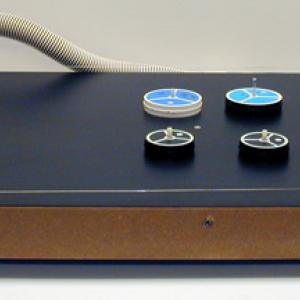College of Liberal Arts & Sciences
1N40.20 - Air Table Collisions
Place the 4 special rod holder at the corners of the table. Push the holders as far in against the table as possible and tighten. Then string the wire through the holes of the holders and attach one end of the wire to one of the holders. Stretch the wire tight and secure with the large spring to an intitial tension. If more tension in the wire is desired, loosen several of the rod holders, move them outward as much as possible, and re-tighten the holder. Level the air table and collide equal and unequal mass hover pucks at different angles.
A #57 drill can be used to clean the holes of the air table should they become plugged.
- Alan J. DeWeerd, "Oblique Collisions Between Billiard Balls for Introductory Physics", TPT, Vol. 62, #9, Dec. 2024, p. 711.
- Lori Shaaban, Justin Dunlap, Ralf Widenhorn, William Guo, "Tracking and Analyzing the Momentum of a Midair Collision Using a 3D Camera", TPT, Vol. 62, #6, Sept. 2024, p. 468.
- Lior M. Burko, "Two-Dimensional Collisions and Conservation of Momentum", TPT, Vol. 57, #7, Oct. 2019, p. 487.
- Peter Kalajian, "Discrepant Results in a 2-D Marble Collision", TPT, Vol. 51, #3, Mar. 2013, p. 173.
- Chiu-king Ng, "Oblique and Head-On Elastic Collisions", TPT, Vol. 46, #4, Apr. 2008, p. 240.
- Robert D. Rosen, "Critical Thinking: Error Sources and Energy in a Conservation of Momentum Lab", TPT, Vol. 46, #4, Apr. 2008, p. 235.
- Akio Saitoh, "Law of Conservation of Momentum Apparatus", TPT, Vol. 44, #8, Nov. 2006, p. 546.
- David T. Kagan and Lynda Klein, "Why Is There No Vertex in Air-Table Collisions?", TPT, Vol. 38, #7, Oct. 2000, p. 414.
- Irvin A. Miller, "Marbles in Collision", TPT, Vol. 27, #9, Dec. 1989, p. 646.
- R. D. Edge, "Two-Dimensional Collisions Using Pendulums", TPT, Vol. 27, #3, Mar. 1989, p. 207.
- Louis H. Cadwell, Robert LaMomtagne, and E. R. Boyko, "Concerning the Probability of a Favorable Two-Dimensional Collision", TPT, Vol. 27, #1, Jan. 1989, p. 32.
- Robert Ehrlich, Richard B. Minnix, and D. Rae Carpenter Jr., "Air Table Experiments Without An Air Table", TPT, Vol. 23, #2, Feb. 1985, p. 113.
- W. Louis Barrett, "Moment of Inertia Measurements on an Air Table", TPT, Vol. 17, #7, Oct. 1979, p. 464.
- S. Mathavan, M. R. Jackson, and R. M. Parkin, "Application of High-Speed Imaging to Determine the Dynamics of Billiards", AJP, Vol. 77, #9, Sept. 2009, p. 788.
- Myung-hyun Ha, Yang-kie Kim, and Sang Bub Lee, "Development Of An Apparatus For Two-Dimensional Collision Experiment Using A Cycloidal Slide", AJP, Vol. 69, #11, Nov. 2001, p. 1187.
- R. Evan Wallace and Michael C. Schroeder, "Analysis of Billiard Ball Collisions in Two Dimensions", AJP, Vol. 56, #9, Sept. 1988, p. 815.
- F. C. Peterson, "Air Tables and the Mystery of the Lost Momentum", AJP, Vol. 56, #5, May 1988, p. 473.
- Helen H. Webb, "Quantitative Study of Linear Momentum in Two Dimensions by Means of Pucks Operated on a Rectangular Air Table", AJP, Vol. 33, #12, Dec. 1965, p. 1027.
- Kevin Anderson, "How to Win at Bar Games", Popular Mechanics, Vol. 192, #2, Feb. 2015, p. 38.
- Robert Ehrlich, "E.4, Collisions on a Vibrating Plate", Turning the World Inside Out, p. 55.
- David Kutliroff, "36, Using a Camera for Producing Strobed Pictures of Trajectories", 101 Classroom Demonstrations and Experiments For Physics Teachers, p. 83.
- David Kutliroff, "31, Massless Elephants on Frictionless Plains", 101 Classroom Demonstrations and Experiments For Physics Teachers, p. 70.
- Borislaw Bilash II and David Maiullo, "Curl It This Way", A Demo a Day: A Year of Physics Demonstrations, p. 122.
- Kenneth Fox and Edited by Karl Mamola, "Momentum Vectors in a Plane", Apparatus for Teaching Physics, p. 83.
- Robert Ehrlich, "Colliding Coins and Transverse Momentum", Why Toast Lands Jelly-Side Down, p. 84 - 86.
- Brian Jones and Matt Fackelman, "Magnetic Collisions", Don't Forget the Duct Tape, p. 81 - 84.
- W. Bolton, "1. Collisions Between Particles", Book 2 - Waves and Particles, Physics Experiments and Projects, 1968, p. 3 - 4.
Disclaimer: These demonstrations are provided only for illustrative use by persons affiliated with The University of Iowa and only under the direction of a trained instructor or physicist. The University of Iowa is not responsible for demonstrations performed by those using their own equipment or who choose to use this reference material for their own purpose. The demonstrations included here are within the public domain and can be found in materials contained in libraries, bookstores, and through electronic sources. Performing all or any portion of any of these demonstrations, with or without revisions not depicted here entails inherent risks. These risks include, without limitation, bodily injury (and possibly death), including risks to health that may be temporary or permanent and that may exacerbate a pre-existing medical condition; and property loss or damage. Anyone performing any part of these demonstrations, even with revisions, knowingly and voluntarily assumes all risks associated with them.
